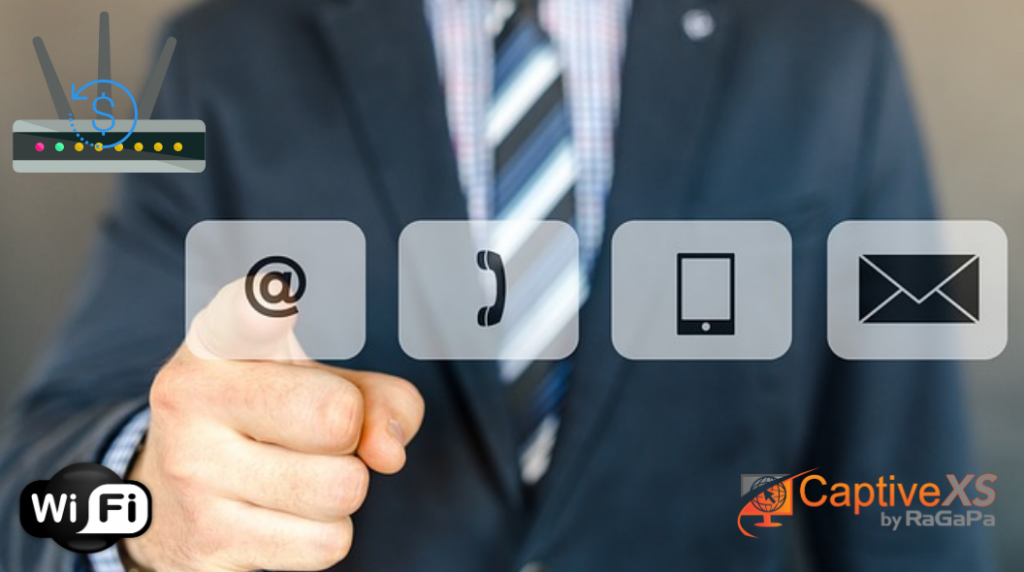
Post-session Engagement
Customers connecting to the venue’s guest WiFi tend to walk out of the location without logging out of the guest WiFi session. So post-session engagement with customers begins when they are out of the venue and have no active Internet session running on the guest WiFi. As the famous marketing quote goes, “out of sight is out of mind”, it applies very well to the customers visiting venues. For WiFi monetization to kick-in effectively, you want the customers to buy more services from you or your partner businesses. For customers to keep getting a recall to your brand’s name, they must be engaged with relevance even when they are not with you – this is at the heart of post-session engagement. Marketers can craft communications that work well to get the customers back to the venue or make the customers take action on their offer.
Inputs for Post-session Engagement
Captive portal used in the guest WiFi solution helps venue marketers acquire essential customer information that is useful during the post-session engagement. Your guest WiFi solution should provide you WiFi analytics on customer data, their behavioral and demographic data so that you are in a position to push better-targeted communication in the post-session engagement. The key attribute to better post-session engagement is to be able to segment the customers based on their data so that the outbound communications are personalized. Personalized engagement is possible if you have a single cloud-managed WiFi analytics dashboard available to slice and dice the customer data and assign campaigns to customers across venues.
Post-session Engagement Tools
While customers are at the venue, you are in a position to engage with them through the captive portal at on-boarding or during the in-session using in-browser content insertion technologies. However, when the customers leave the place, you have their email address, phone number, and the app if they have installed your app. There are specific strategies to engage with customers when they are off-campus, there are tools that can help you achieve a better post-session engagement:
Email Engagement
You can engage customers over email who had left their email address with you in return for Internet access when they were with you. Emails are an effective means of engagement post-session when the timing of the email, and the relevance of the message is appropriate.
For example, newly registered (first-time)customers receiving an email asking “how was your first experience with us?” as part of the post-session engagement, generates a good brand recall value. Another example is when you have a new offer, especially on the products/ services that specific segment of customers are seen to consume regularly, sending an email regarding such an offer to them generates more incremental revenue from the offer campaign.
Text Message Engagement
You can engage customers over SMS text messages who have left their mobile phone numbers while accessing the guest WiFi. The mobile phone is a personal device, and SMS communication is a great way to reach customers when you have something very contextual to share with them, without spamming. SMS helps the brand name be visible to the customers while they are away from the venue. Just like email, the SMS mode of engagement also requires that the timing and triggers of message communication be appropriate.
App Notification Engagement
If the customers have installed your app, then you can engage with the customers using personalized app notifications. You know their typical days/ times to visit you, and based on that behavior you may send them a message if you didn’t have them visit on one of the days. App notifications can have a deeper integration with the user’s behavior pattern. Post-session notifications on the app are an effective mechanism to get the users to not only revisit the venue but also have them take action on offer inside the app itself.
While more brands strive to engage their customers post-session, many of these might end up creating much noise for the customer. For you to stand out as a brand that relates much better to the customers, you need the post-session engagement to be driven based on guest WiFi analytics. More contextual engagement helps customers make quicker decisions and thereby help you drive better monetization through the guest WiFi. Innovative marketers are turning to sequential customer engagement by first engaging on email, then on SMS and lastly if available then on app notifications or direct call; this helps marketers learn the channel preference of the customer and engage with them on that channel post session.
RaGaPa’s CaptiveXS solution has been a pioneer in the space of guest WiFi monetization, and we have been helping venues of all sizes engage effectively with their customers during the session as well as post-session. Contact us to learn more about how to manage customers’ post-session engagement in WiFi marketing.
